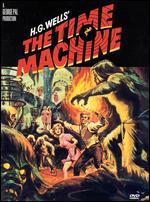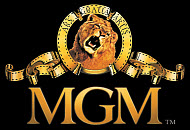The Time Machine
Reviewed by: Brett Willis
CONTRIBUTOR
| Moral Rating: | Average |
| Moviemaking Quality: |
|
| Primary Audience: | Teen to Adult |
| Genre: | Sci-Fi |
| Length: | 1 hr. 43 min. |
| Year of Release: | 1960 |
| USA Release: |

| Featuring |
|---|
| Rod Taylor, Yvette Mimieux, Alan Young, Sebastian Cabot, Tom Helmore |
| Director |
|
George Pal |
| Producer |
| George Pal |
| Distributor |
This film is historically important, because it’s the only widely-available adaptation of the 1895 H.G. Wells novel (although that’s soon to change), and because it’s the functional ancestor of later films on the same theme (“Back to the Future” copies the house full of clocks and the talk about thinking fourth-dimensionally). The special effects won an Oscar.
On Dec. 31, 1899 a British scientist, “George” (Rod Taylor), demonstrates a small working model of a time machine to his friends. When he hits the control lever, the machine disappears. His friends aren’t convinced. Dr. Hillyer (Sebastian Cabot) argues that time-travel—especially backward time-travel—is impossible because the future is fixed and can’t be changed. Biblically, he’s correct. God knows the end from the beginning, as shown by direct statement (Isa. 41:4; 48:3-5) as well as by fulfillment of minutely-detailed prophecies (Genesis Chs. 40 and 41; 1 Sam. 10:1-9; 1 Ki. 13:1,2 with 2 Ki. 23:15-18; Isa. 44:28-45:6 with Ezra 1:1-3; Daniel Chs. 4 and 5; Mark 14:12-16; John 6:64); so there cannot be two “ends” for the same “beginning.” Standard physics also says that backward time-travel is impossible. But within this fictitious story, there’s both forward and backward time-travel.
George agrees to meet his friends again five days later, and in the meantime uses a full-size time machine to journey to the future and back again. Actually the second meeting is shown first and the rest is flashback, allowing George to supply voiceovers during his journeys. George passes through WWI and WWII (the screenwriters had the benefit of hindsight) plus an imaginary nuclear war set in 1966, six years after the film’s release. Volcanic eruptions triggered by the nukes bury him and his machine in lava, but he’s unhurt due to his time-travel speed. When the lava mountain around him has worn away, the year is 802,701 A.D. He meets a race of childlike blond, blue-eyed people, the Eloi; and rescues one of their women, Weena (Yvette Mimieux), from drowning. Since the Eloi do no work and don’t care about anything, George can’t figure out how they’re fed and clothed—until he discovers that other descendants of humans, the apelike, underground-dwelling Morlocks, provide for the Eloi’s needs but also eat them as though they were cattle. When Weena and other Eloi are taken underground to be slaughtered, George must save her a second time.
Content
No profanity, except one “I’ll be d*” from Dr. Hillyer. Special effects of a nuclear attack on England, but no visible deaths. A quick-budding romance between George and Weena, but no sexual content. A lot of violence and some blood as George kills several Morlocks while rescuing Weena. A glimpse of a large cave full of Eloi skeletons. As George escapes from 802,701 he at first goes farther into the future and watches the time-lapse decay of the body of a Morlock that he’d just killed.
Underlying Philosophy (Film): Definitely antiwar in outlook. Nothing wrong there except that (as I learned while I was a ’60s activist) the leadership of the antiwar movement intends to abolish war by instituting one-world government. John Lennon said it well: “Imagine there’s no countries—nothing to kill or die for.” God sent the judgment at the tower of Babel (Gen. 11:1-9) to break up one-world government.
Underlying Philosophy (Novel)
H.G. Wells (War of the Worlds, First Men in the Moon, Island of Dr. Moreau) studied under evolutionist Thomas Huxley, and was a Fabian Socialist (that means his goals were the same as those of the Communists, but he believed they could be achieved by gradual, nonviolent change through “reeducation”). Up till Wells’ time, most “science fiction” (such as the best work of Jules Verne) was intended as reasonable guesses at what real science might accomplish in the future. Wells was a pioneer in transforming the science fiction genre into the humanist, socialist, one-worldist, Darwinist and spiritualist propaganda tool that it still is today (with feminism and environmentalism now tacked on for good measure).
Although Wells would probably have been pleased with the antiwar polemic of this film version, the novel has a different thrust. In the film, the two new species are descended from groups of people who randomly decided to sit out Nuclear Winter above or below ground. The novel explicitly makes the Eloi the descendants of the indolent, leisured ruling class and the Morlocks the descendants of the working class. The time-traveler conjectures that the rich weren’t content to consign the working class to visible slums; they sent them underground, then forgot to feed them. that’s a pretty heavy-handed warning that if the Capitalists don’t start treating common working people better, they may someday become the slaves rather than the masters. [The “Time Machine” page on one H.G. Wells Web site suggests three additional readings: Marx’ “Alienated Labor,” Marx’ and Engels’ “The Communist Manifesto” and Darwin’s “The Origin of Species.”]
The novel also has the scientist travel 30 million years into the future, to a time when man and most other life is extinct and the sun is dying out. it’s reported that President Woodrow Wilson, after reading this novel, caught Wells at a party and distraughtly pleaded with him that even if our destiny is extinction, life must have some meaning. I thank God that I know I’m not an accident, my existence is meaningful, and I can look forward to something beyond this present life (1 Cor. 15:19-22).
There was a made-for-TV 1978 remake of this film. Another remake is scheduled for theatrical release on Christmas 2001. The upcoming version stars Guy Pearce (“L.A. Confidential,” Memento, Rules of Engagement) and is directed by Simon Wells (“Fievel Goes West,” “Balto,” “The Prince of Egypt”) who is H.G. Wells’ great-grandson. According to the preliminary screenplay, the new version departs even farther from the novel than this version did.




My Ratings: [Better than Average / 4]